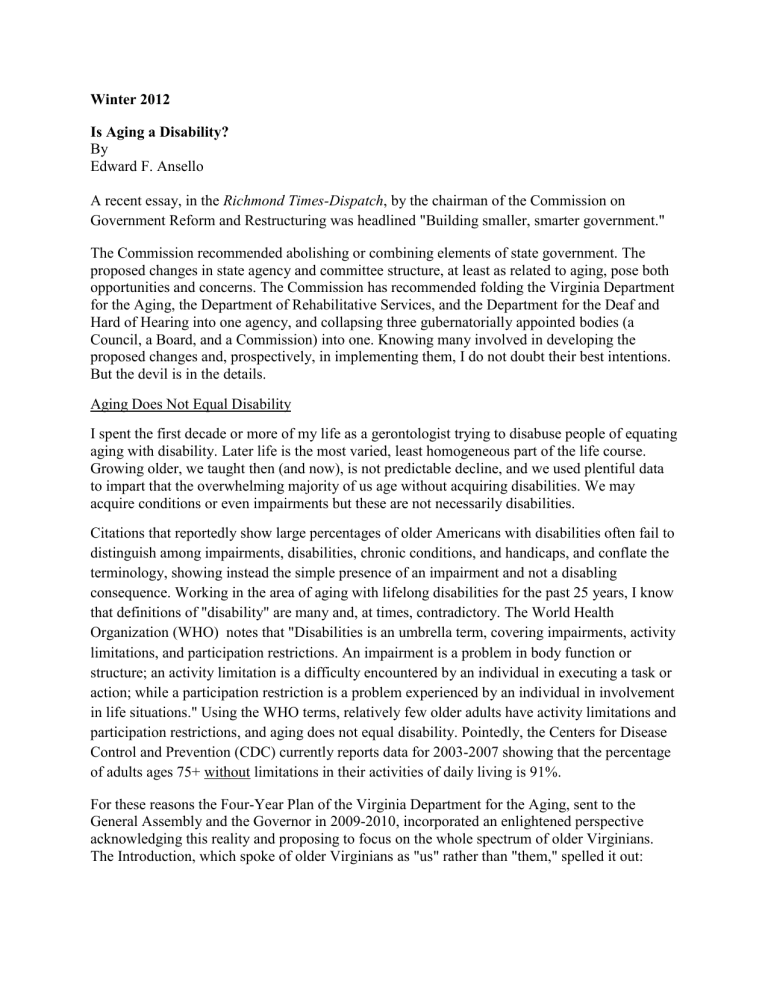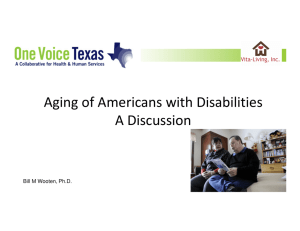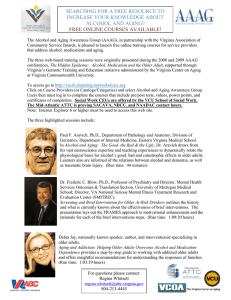Winter 2012 Is Aging a Disability? By Edward F. Ansello

Winter 2012
Is Aging a Disability?
By
Edward F. Ansello
A recent essay, in the Richmond Times-Dispatch , by the chairman of the Commission on
Government Reform and Restructuring was headlined "Building smaller, smarter government."
The Commission recommended abolishing or combining elements of state government. The proposed changes in state agency and committee structure, at least as related to aging, pose both opportunities and concerns. The Commission has recommended folding the Virginia Department for the Aging, the Department of Rehabilitative Services, and the Department for the Deaf and
Hard of Hearing into one agency, and collapsing three gubernatorially appointed bodies (a
Council, a Board, and a Commission) into one. Knowing many involved in developing the proposed changes and, prospectively, in implementing them, I do not doubt their best intentions.
But the devil is in the details.
Aging Does Not Equal Disability
I spent the first decade or more of my life as a gerontologist trying to disabuse people of equating aging with disability. Later life is the most varied, least homogeneous part of the life course.
Growing older, we taught then (and now), is not predictable decline, and we used plentiful data to impart that the overwhelming majority of us age without acquiring disabilities. We may acquire conditions or even impairments but these are not necessarily disabilities.
Citations that reportedly show large percentages of older Americans with disabilities often fail to distinguish among impairments, disabilities, chronic conditions, and handicaps, and conflate the terminology, showing instead the simple presence of an impairment and not a disabling consequence. Working in the area of aging with lifelong disabilities for the past 25 years, I know that definitions of "disability" are many and, at times, contradictory. The World Health
Organization (WHO) notes that "Disabilities is an umbrella term, covering impairments, activity limitations, and participation restrictions. An impairment is a problem in body function or structure; an activity limitation is a difficulty encountered by an individual in executing a task or action; while a participation restriction is a problem experienced by an individual in involvement in life situations." Using the WHO terms, relatively few older adults have activity limitations and participation restrictions, and aging does not equal disability. Pointedly, the Centers for Disease
Control and Prevention (CDC) currently reports data for 2003-2007 showing that the percentage of adults ages 75+ without limitations in their activities of daily living is 91%.
For these reasons the Four-Year Plan of the Virginia Department for the Aging, sent to the
General Assembly and the Governor in 2009-2010, incorporated an enlightened perspective acknowledging this reality and proposing to focus on the whole spectrum of older Virginians.
The Introduction, which spoke of older Virginians as "us" rather than "them," spelled it out:
One of the most significant breakthroughs in our understanding is that, as we grow older, we tend to grow less alike.....On virtually every important dimension, from health to income to acquired skills and experience, aging increases the variety within each generation. Simply put, there is greater variability in characteristics and function among 75 year olds than among 45 year olds.....Viewing later life on a continuum, the vast majority of us will be healthy, active contributors to our communities. Most of us will need information; some will need intermittent services; fewer still will need coordinated long term services to delay or prevent institutionalization; and a smaller number will require facility-based care.....Often government reports focus almost exclusively on older adults in need, an understandable priority, yet ignoring us also as resources, as volunteers, as experienced employees, as caregivers, as grandparents raising grandchildren, and as citizens actively engaged in the civic structure.
Collapsing Committees
The Commission recommended collapsing not only the three agencies mentioned above but also three advisory bodies housed within VDA: the Commonwealth Council on Aging, the Virginia
Public Guardian and Conservator Advisory Board, and the Alzheimer's Disease and Related
Disorders Commission. For ease of communication, I will call these "committees." The proposed collapse of the three into one committee poses both philosophical and practical challenges to maintaining Virginia's commitment to all older Virginians.
The purposes and operations of the three committees are quite different. The focus of the
Commonwealth Council on Aging is broad, reflecting aging's breadth. Recent quarterly agendas illustrate this. The committee's 19 members, volunteers from across sectors and geographies, dealt with issues as diverse as housing, healthcare, elder rights, and best practices in community services. The 15 members of the Public Guardian committee focus on indigent, vulnerable
Virginians, especially those with mental illnesses, cognitive impairments like intellectual disabilities and autism, and other conditions that restrict their ability to execute judgment. The work of the Alzheimer's Commission embraces research, on-line training, shared data bases, public awareness, and a state plan related to dementia; it maintains the "Alz's possible" website
(www.alzpossible.org) offering resources and webinars for family caregivers and service providers. The three bodies have little overlap in focus. They do have in common that they are comprised of citizens who are concerned community leaders and professionals in related fields who are donating their time and expertise.
Challenges to Effective Functioning
How would a combined super-committee work? Three options come immediately to mind: 1) there would be one omnibus committee representing the pooling of the three formerly separate committees; it would be one having dozens of members with little overlapping interests. As well, this would be logistically unwieldy: when and where might their very large membership meet? 2) the omnibus committee would have three separate subcommittees, operating as before the restructuring. In this case, what is the gain other than changing a digit on a government organizational chart from a "3" to a "1"? 3) the combined committee's size would be greatly
reduced by eliminating appointments to each of the three committees that constitute the new whole. This would mean jettisoning great amounts of donated time and expertise; what would be the gain to the Commonwealth? Members of each of the three committees are volunteers and I know from my terms on the Alzheimer's Commission (appointed by Governors Gilmore and
Warner) that state appropriations for its operation were calculated in modest hundreds of dollars.
Smaller, smarter government? The logic seems elusive. Philosophically, practically, and economically, questions arise about collapsing these aging-related entities. Collaboration among the three agencies would seem more productive than integration. Parenthetically, by adopting the
Restructuring Commission's recommendations, the estimated total savings potentially realized across all Secretariats of state government, not just those that are aging-related, would be 2.2 million dollars in an 82 billion dollar budget, or less than 3 cents on $100. The purported savings within the aging-related realm, of course, would be just a portion of this. Unanswered is how much the loss of donated expertise from any collapse of the committee membership would offset this savings.
One has to ask if these proposed aging-related collapses, as related to the three agencies, represent a diminishment of aging and, as related to the three committees, a loss of government of and by the people .




